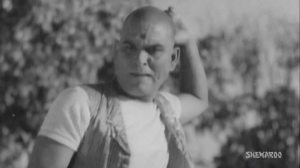
Aurat, a social melodrama, forms part of Mehboob’s period of filmmaking that saw him shift between the studio system of the 1930s and early 1940s before he went independent. He made a number of key films for National Studios including Roti. Mehboob was a studio bound filmmaker, working in many genres and often collaborating with the same technical crew including cinematographer Faredoon A. Irani. His post-independence work is what still garners attention amongst film fans and his colour period resulted in populist classics such as Aan & Mother India. His films also had a remarkably consistent presence at the box office and he had the flair to make even the most unappealing political films of his career such as Roti (1942) succeed with film audiences. So much of Mehboob’s early films has either simply been forgotten, lost to time or have been rendered inaccessible. This was certainly the case with Roti that only recently surfaced online and which I have argued is a key work in pre-independence Hindi cinema both in terms of its political content and appreciating fully Mehboob’s auteur status.
Aurat was recently reissued on DVD by Shemaroo and subsequently uploaded to their Vintage YouTube channel. I am not entirely sure who owns the rights to Roti or Aurat, maybe it is the Mehboob Khan estate, but since the copyright has lapsed on both of these films they have arguably entered the public domain, which seems somewhat sneaky of DVD labels to re-issue these films hoping to make a profit from them. Now, had the films been restored and then re-released in new prints including special features then it would make perfect sense and one would dually buy into such an enterprise. Alas, given the despairing state of DVD authoring and manufacturing in India, films like Aurat are likely to continue circulating in the realm of BitTorrents. What remains to be seen is, if and when, the work of Mehboob is likely to be restored and released in two separate retrospectives; pre and post independence.
Aurat is the story of Radha, a peasant woman of considerable fortitude, left to fend for her four children when her husband burdened with the weight of impoverishment leaves the village, abandoning his family. Through hunger Radha loses two of her children but still succeeds in raising her two remaining sons who grow up to become polar opposites; Birju, the outright rebel and bandit, and Ramu, the romantic, doting son. The narrative template of a mother, the interests in female narratives is a recurring theme in Mehboob’s films, and her two conflicting sons immeasurably influenced dozens of Hindi films. Imagining nationhood through the symbolic coding of the mother figure would reach a Nehruvian zenith with Nargis as Mother India. Sardar Akhtar is equally accomplished in her unassuming performance as Radha, a feminist portrait, growing to occupy a position of respect and autonomy in the village.
In Deewaar, the trade unionist father, ostracized from the village for selling out his fellow workers has its antecedents in Aurat when Shamu abandons his family, the crisis of masculinity insurmountably deathly in its discordant musings. In one of the boldest sequences in the film, Mehboob uses a series of bold superimpositions and deep focus photography, juxtaposing Shamu’s male despair to the quandary of poverty:
Since the quality of the video I watched varied considerably, the photographic work of Irani still shone through, framing the village in pastoral landscapes of elemental riches, clouds, water and earth, reminiscent of Soviet cinema and the cinema of Dovzhenko that intersects with Raj Kapoor’s Awaara and Bimal Roy’s Do Bigha Zamin. This nostalgic view of the village, complemented by the traditional folk music by Anil Biswas, is an aspect of Indian rural life that often appears in Mehboob’s work while his criticisms of modernity in terms of its impact on ordinary Indian culture predates Satyajit Ray and many other Indian directors. One can see Mehboob and his regular editor Shamsudin Kadri experimenting with editing devices such as the dissolve, used masterfully to mark the transition of Birju from boy to man:
One of the noted parallels between Aurat and Mother India is the unruly, scheming figure of the moneylender Sukhilala (actor Kanhaiyalal Chaturvedi would reprise his role) manipulating the despair of the villagers and trying his best to take advantage of Radha’s misfortunes. Sukhilala upsets the equilibrium of the village since his moneylending interpreted, as a capitalist critique, is a source of hostility that antagonises Birju, like it did his father, pointing to cyclical notions of wounded male pride and impotency that can only be resolved by a tragic mortality. Such a deep, eternal realisation is delineated by Mehboob’s dolly shot on Radha’s horrified face (see below) after she has shot Birju, a cataclysmic rupturing of rural laws and Oedipal complications.
We have had a monograph on Mother India (BFI) by Gayatri Chatterjee and two publications on Mehboob as a director; one by Rauf Ahmed that is underwritten and very basic and also a biography by Bollywood insider Bunny Reuben. Neither of them provides a comprehensive analysis of Mehboob as an auteur since much of his work still remains inaccessible, suggesting a reclaiming of his earlier works as they slowly become available is likely to be a revisionist task.










Leave a comment